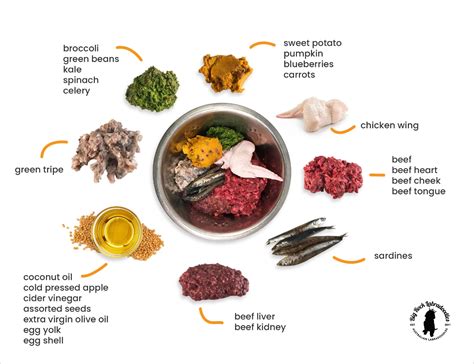Canine Raw Diet Recipes: A Comprehensive Guide for Healthy, Happy Dogs
Are you considering a raw food diet for your canine companion? Raw feeding offers potential benefits like improved digestion, shinier coat, and increased energy levels. However, it's crucial to understand the specific nutritional needs of dogs and how to formulate a balanced and safe raw diet. This comprehensive guide provides several canine raw diet recipes and essential information to ensure your furry friend thrives.
Understanding the Basics of a Raw Diet for Dogs
Before diving into specific recipes, let's explore the fundamental principles of a canine raw food diet. A balanced raw diet should consist of:
- Protein: This forms the largest portion, typically 60-80% of the diet. Good sources include muscle meat (beef, chicken, turkey, lamb), organ meats (liver, kidney, heart), and bone.
- Fat: Essential for energy and nutrient absorption. Sources include fatty fish (salmon, mackerel), bone marrow, and organ meats. Aim for around 15-25% of the total diet.
- Bone: Provides essential minerals like calcium and phosphorus. Raw meaty bones (RMBs) are a crucial part of the diet, helping with dental health and providing natural calcium. Never give cooked bones.
- Vegetables and Fruits (optional): These should comprise a smaller portion (around 5-10%) and offer added vitamins and fiber. Choose options like carrots, spinach, blueberries, and apples. Always introduce new vegetables gradually to monitor for any digestive issues.
Recipe Considerations: Safety and Balance
Crucial Safety Note: Always source your ingredients from reputable suppliers. Ensure meat is fresh and properly handled to avoid bacterial contamination. Thoroughly wash your hands after handling raw meat. Consult with your veterinarian before starting your dog on a raw food diet. They can help determine if it's suitable for your dog's specific needs and health conditions.
Sample Canine Raw Diet Recipes
Remember, these are sample recipes. Adjust portion sizes according to your dog's size, activity level, and age. Always weigh your ingredients for accurate nutritional balance.
Recipe 1: The "Basic" Raw Meal
- 80% Muscle Meat (Beef, Chicken, or Turkey): Chopped into bite-sized pieces.
- 10% Bone: Raw meaty bones (RMBs) – choose appropriate size for your dog. Avoid splintering bones.
- 5% Organ Meat (Liver or Heart): Provides essential vitamins and minerals.
- 5% Vegetables (Carrots, Spinach, Green Beans): Finely chopped or pureed for smaller breeds.
Recipe 2: The "Salmon Surprise"
- 70% Muscle Meat (Chicken): Chopped into bite-sized pieces.
- 15% Fatty Fish (Salmon): Skin and bones removed – rich in Omega-3 fatty acids.
- 10% Bone: Raw meaty bones (RMBs)
- 5% Vegetables (Broccoli, Peas): Finely chopped.
Tips for Successful Raw Feeding
- Introduce gradually: Avoid making a drastic switch. Transition your dog to a raw diet gradually over 7-10 days.
- Monitor your dog: Pay attention to stool consistency and overall health. Adjust the recipe as needed.
- Supplement if necessary: Your veterinarian may recommend supplements to ensure complete nutritional balance.
- Proper storage: Store raw food properly to prevent spoilage.
- Food safety: Maintain strict hygiene when preparing and handling raw food.
Conclusion
A raw food diet can be a beneficial option for some dogs, providing potential health advantages. However, careful planning, responsible sourcing, and regular veterinary check-ups are essential. Remember to consult your vet before making any major dietary changes for your canine companion. By following these guidelines and recipes, you can help ensure your dog receives the optimal nutrition for a happy and healthy life.
